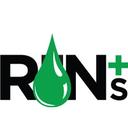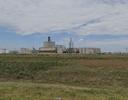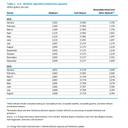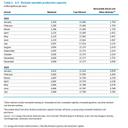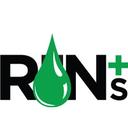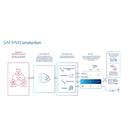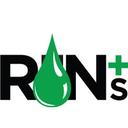Despite the challenges it currently faces, the bio-based diesel industry is building on its successes and is ready to battle.
The U.S. EPA on Nov. 16 released updated RIN data, reporting that nearly 2.11 billion RINs were generated under the RFS in October, up from 1.81 billion generated during the same month of last year.
Conestoga Energy and SAFFiRE Renewables LLC announced on Nov. 16 their agreement for Conestoga to host SAFFiRE’s cellulosic ethanol pilot plant at Conestoga’s Arkalon Energy ethanol facility in Liberal, Kansas.
Officials at Calumet Specialty Products Partners L.P. discussed the company’s proposed plans to boost sustainable aviation fuel (SAF) production at its Montana Renewables biorefinery during third quarter earnings call, held Nov. 9.
SATORP, platform jointly owned by Aramco (62.5 percent) and TotalEnergies (37.5 percent), has for the first time in the MENA region successfully converted used cooking oil through coprocessing into ISCC+ certified SAF.
U.S. biofuels operable production capacity was up slightly in August, with a small gain for ethanol, according to data released by the U.S. EIA on Oct. 31. Feedstock consumption was down slightly from the previous month.
Phillips 66 has confirmed the renewables conversion of its refinery in Rodeo, California, is progressing on schedule with startup expected in Q1 2024. Once fully operational, the facility will have the capacity to produce 800 MMgy of renewable fuels.
NREL: Midwestern electrofuels could become energy superheroes
NREL research demonstrates how carbon dioxide captured at Midwestern ethanol plants could be processed with electrolyzers powered by wind energy to produce electrofuels, specifically sustainable aviation fuel (SAF).
Valero Energy Corp. released Q3 financial results on Oct. 26, reporting significantly higher earnings and production volumes for its ethanol segment. Renewable diesel sales volumes were also up and the company’s SAF project remains on schedule.
Neste Corp. released third quarter financial results on Oct. 26, reporting a 40 percent increase in comparable EBITDA for its Renewable Products segment. Margins and sales volumes for renewable diesel and SAF were also up.
2024 International Biomass Conference & Expo opens call for abstracts
The call for presentation abstracts for the 17th Annual International Biomass Conference & Expo, produced by Biomass Magazine, is now open. The event will take place March 4-6, 2024, at the Greater Richmond Convention Center in Richmond, Virginia.
Nearly 1.95 billion RINs were generated under the RFS in September, up from 1.73 billion generated during the same month of 2022, according to data released by the U.S. EPA. Total RIN generation for the first nine months of 2023 was at 17.41 billion.
Honeywell and GranBio Technologies on Oct. 10 announced that they will combine Honeywell’s ethanol to jet (ETJ) technology with GranBio’s cellulosic ethanol AVAP technology to produce carbon-neutral SAF from biomass residues.
The Council of the European Union on Oct. 9 adopted regulations for the ReFuelEU initiative. The new law aims to boost both the demand for and supply of sustainable aviation fuel (SAF) within the European Union.
Wet waste—including food waste, manure, sewage, and inedible fats, oils, and greases—is a large source of methane emissions. NREL scientists have created a biorefining process that can convert that material into SAF.
Operable biofuels production capacity in the U.S. expanded slightly in July, according to data released by the U.S. Energy Information Administration on Sept. 29. Feedstock consumption was up when compared to both the previous month and July 2022.
The Federal Aviation Administration on Sept. 25 launched a new competitive grant program that, in part, can support projects to add sustainable aviation fuel (SAF) production capacity to existing renewable diesel and ethanol plants.
Portugal-based energy company Galp SGPS S.A. and Japan-based Mitsui & Co. Ltd. on Sept. 25 announced plans to form a joint venture that will develop renewable diesel and SAF capacity at Galp’s existing refinery in Sines, Portugal.
The U.S. DOE has released a RFI to better understand the challenges facing critical elements within SAF supply chains. The agency is specifically seeking input from industry, academia, research laboratories, government agencies, and stakeholders.
The U.S. EPA on Aug. 21 released data indicating nearly 2.04 billion RINs were generated under the RFS in August, up from 1.84 billion generated in August 2022. Total RIN generation for the first eight months of the year reached nearly 15.45 billion.
LanzaJet and Technip Energies on Sept. 19 announced an agreement to strengthen their exclusive collaboration to support the global deployment of the LanzaJet Alcohol-to-Jet (ATJ) Process technology for the production of SAF.
VARO Energy on Sept. 7 announced the construction of a large-scale sustainable aviation fuel (SAF) manufacturing facility at the Gunvor Energy Rotterdam site, investing $600 million with the aim of helping its airline customers decarbonize.
Lummus Technology has announced the commercial availability of its ethanol-to-SAF process technology. The technology provides operators with a large-scale, commercially demonstrated solution to reduce the aviation industry's GHG emissions.
Through the GREATER MSP Partnership, Bank of America, Delta Air Lines, Ecolab and Xcel Energy have established the Minnesota SAF Hub – the first large-scale SAF Hub in the U.S. committed to scaling SAF production.
More than 1.98 billion RINs were generated under the RFS in July, up from 1.71 billion generated during the same month of last year. Total RIN generation for the first seven months of 2023 reached 13.4 billion.
Pertamina, a national energy company in Indonesia, has successfully condcuted static tests on sustainable aviation fuel (SAF) on CFM56-7B jet engines commonly used in commercial aircraft at GMF Aeroasia's Test Cell facility.
Shandong Haike Chemical Co. Ltd, a Chinese refining and petrochemical company, has selected Axens’ Vegan technology to produce low-carbon, cost-competitive sustainable aviation fuel (SAF) by retrofitting its existing assets.
Todd Borgmann, CEO of Calumet Specialty Products L.P., on Aug. 4 announced that all elements of the company’s Montana Renewables project met or outperformed expectations during the second quarter of 2023.
Neste released second quarter financial results on July 27, reporting robust demand for renewable diesel and relatively stable feedstock pricing. SAF and renewable diesel sales were up 17 percent when compared to the second quarter of 2022.
Valero Energy Corp. released second quarter financial results on July 27, reporting improved operating income for both its renewable diesel and ethanol business segments. The company also said its SAF project is progressing on schedule.
Advertisement


